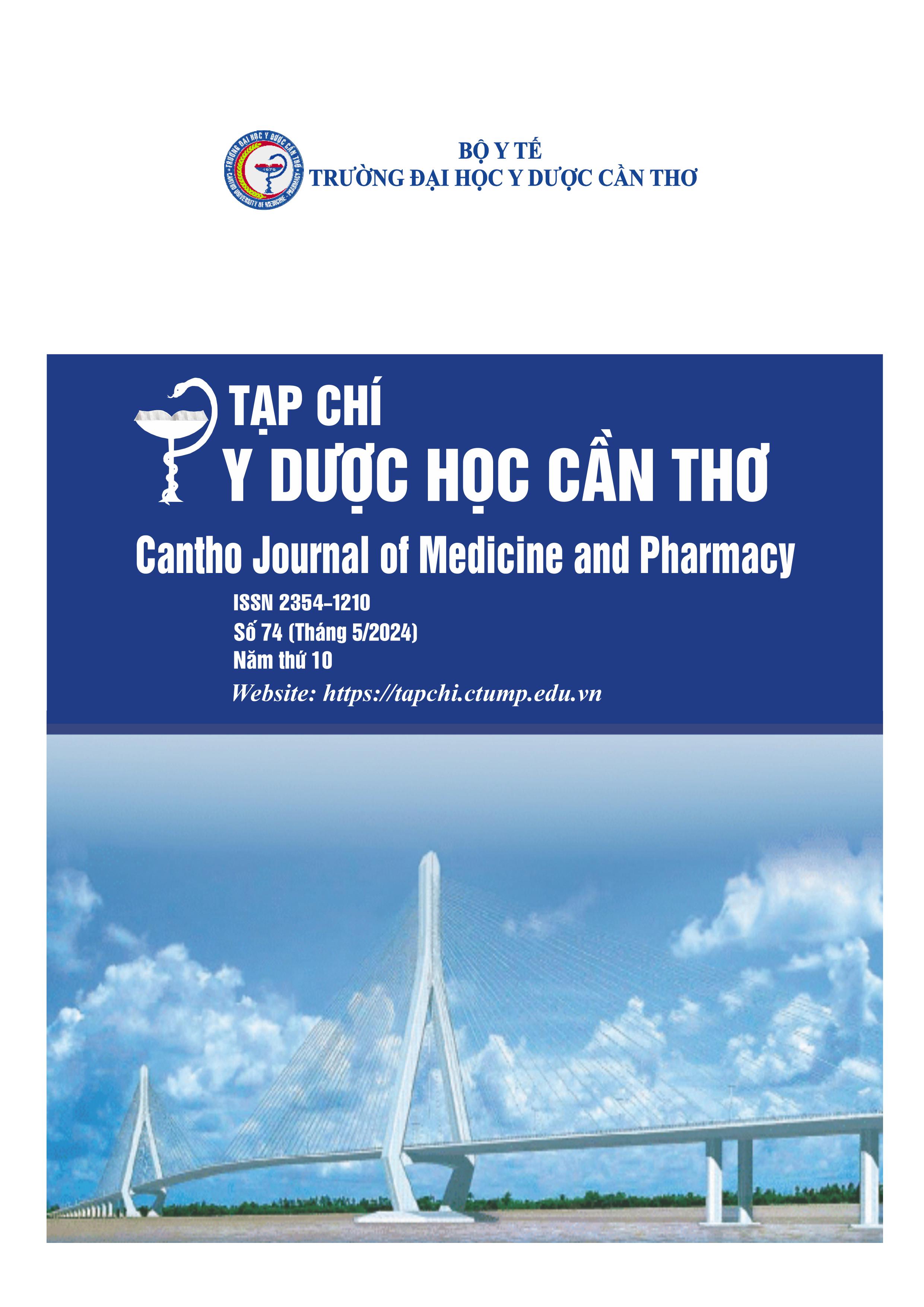THE TOXICITY OF MOUTHWASH CONTAINING CHLORHEXIDINE AND CHLORINE DIOXIDE ON HUMAN GINGIVAL FIBROBLAST
Main Article Content
Abstract
Background: Although chlorhexidine is considered to date a gold standard of antimicrobial rinses that reduces biofilm and has been shown to reduce gingivitis and halitosis, its prolonged usage can have several adverse effects, including extrinsic tooth staining. Chlorine dioxide is a highly antibacterial substance for purifying water sources and has recently been used in dentistry. This agent has also been proven safe for human cells. Combining chlorhexidine and chlorine dioxide may reduce the disadvantages of chlorhexidine while still ensuring antibacterial ability. Still, the toxicity of the mixture to the oral environment needs to be evaluated before examining its antimicrobial effect. Objectives: To investigate the toxicity of mouthwash that contains chlorhexidine and chlorine dioxide on human gingival fibroblast. Materials and methods: Human gingival fibroblasts were incubated with the mouthwash solutions containing chlorhexidine and chlorine dioxide at the corresponding concentrations: solution A (chlorhexidine 0.01%, chlorine dioxide 0.05%), solution B (chlorhexidine 0.02%, chlorine dioxide 0.01%), and C (chlorhexidine 0.05%, chlorine dioxide 0.05%), with contact times simulating actual gargling times of 30 seconds, 60 seconds, 90 seconds, 120 seconds, 150 seconds and 180 seconds. The effect of those solutions on human gingival fibroblast was determined by the MTT (3-(4.5-Dimethylthiazol-2-YL)-2.5- diphenyl tetrazolium bromide) method. The Formosan crystals collected were dissolved in Ehthanol/DMSO solution, and the formed purple solution was absorbed at a 570 nm wavelength. The cellular toxicity grades were determined according to ISO 10993 - 5: 2009; cell morphology and the relative growth rate were also observed. Results: In 30 to 90 seconds, solution A did not affect the survival of the human gingival fibroblast (cellular toxicity level 1 with a relative growth rate of 75-99%). Solutions B and C were toxic for the fibroblasts during the timeline. Conclusions: Human gingival fibroblast can be safe in a mixing solution containing 0.01% chlorhexidine and 0.05% chlorine dioxide for up to 90 seconds.
Article Details
Keywords
Chlorhexidine, chlorine dioxide, toxicity, human gingival fibroblast
References
2. Kerémi B., Márta K., Farkas K., Czumbel L.M., Tóth B., et al. Effects of chlorine dioxide on oral hygiene - A systematic review and meta-analysis. Curr Pharm Des. 2020. 26(25), 30153025, doi: 10.2174/1381612826666200515134450.
3. Diar-Bakirly S., El-Bialy T. Human gingival fibroblasts: Isolation, characterization, and evaluation of CD146 expression. Saudi J Biol Sci. 2021. 28(4), 2518-2526, doi: 10.1016/j.sjbs.2021.01.053.
4. Nguyễn Thị Thu Sương, Nguyễn Thị Ngọc Mỹ, Phạm Anh Vũ Thụy. Ảnh hưởng của axit boric lên khả năng sống của tế bào gốc dây chằng nha chu người in vitro. Y học TP.Hồ Chí Minh. 2018. Tập 22, số 5, 161-169.
5. ISO E 10993-5. Biological Evaluation of Medical Devices. Part 5: Tests for In Vitro Cytotoxicity. International Organization for Standardization: Geneva, Switzerland. 2009.
6. Brookes Z.L.S, Bescos R., Belfield L.A., Ali K., Roberts A. Current uses of chlorhexidine for management of oral disease: a narrative review. J Dent. 2020. 103, 103497, doi: 10.1016/j.jdent.2020.103497.
7. Mor-Reinoso C., Pascual A., Nart J., Quirynen M. Inhibition of de novo plaque growth by a new 0.03 % chlorhexidine mouth rinse formulation applying a non-brushing model: a randomized, double-blind clinical trial. Clin Oral Investig. 2016. 20(7), 459-467, doi: 10.1007/s00784-015-1625-y.
8. Anna H., Barnabás P., Zsolt L. and Romána Z. Tracking of the degradation process of ethylenediaminetetraacetic acid and chlorhexidine digluconate in the presence of hyper-pure chlorine dioxide in endodontic disinfection. J Pharm Biomed Anal. 2019. 164, 360-364, doi: 10.1016/j.jpba.2018.11.005.
9. Nguyễn Ngọc Hoài Bảo và Trần Xuân Vĩnh. Đánh giá ảnh hưởng in vitro của gel chlorhexidine in situ 0,5% lên sự sống và di chuyển của nguyên bào sợi nướu người. Tạp chí y học Việt Nam. 2021. Tập 502, số 2, 175-178.
10. Redding W.R., Booth L.C. Effects of chlorhexidine gluconate and chlorous acid-chlorine dioxide on equine fibroblasts and Staphylococcus aureus. Vet Surg. 1991. 20(5), 306-310, doi: 10.1111/j.1532-950x.1991.tb01272.x.
11. Kőhidai Z., Takács A., Lajkó E., Géczi Z., Pállinger É., et al. The effects of mouthwashes in human gingiva epithelial progenitor (HGEPp) cells. Clin Oral Investig. 2022. 26(6), 4559-4574, doi: 10.1007/s00784-022-04422-z.
12. Lessa F.C., Aranha A.M., Nogueira I., Giro E.M., Hebling J., et al. Toxicity of chlorhexidine on odontoblast-like cells. J Appl Oral Sci. 2010. 18(1), 50-58. doi: 10.1590/s167877572010000100010.
13. Láng O., Nagy K.S., Láng J., Perczel-Kovách K., Herczegh A., et al. Comparative study of hyperpure chlorine dioxide with two other irrigants regarding the viability of periodontal ligament stem cells. Clin Oral Investig. 2021. 25(5), 2981–2992, doi: 10.1007/s00784-020-03618-5.
14. Soares L.G., Guaitolini R.L., Weyne Sde C., Falabella M.E., Tinoco E.M., et al. The effect of a mouth rinse containing chlorine dioxide in the clinical reduction of volatile sulfur compounds. Gen Dent. 2012, 61(4), 46-49.
15. Noszticzius Z., Wittmann M., Kály-Kullai K., Beregvári Z., Kiss I., et al. Chlorine dioxide is a size-selective antimicrobial agent. PLoS One. 2013. 8(11), e79157, doi: 10.1371/journal.pone.0079157.
16. Nishikiori R., Nomura Y., Sawajiri M., Masuki K., Hirata I., et al. Influence of chlorine dioxide on cell death and cell cycle of human gingival fibroblasts. J Dent. 2008. 36(12), 993-998, doi: 10.1016/j.jdent.2008.08.006.


